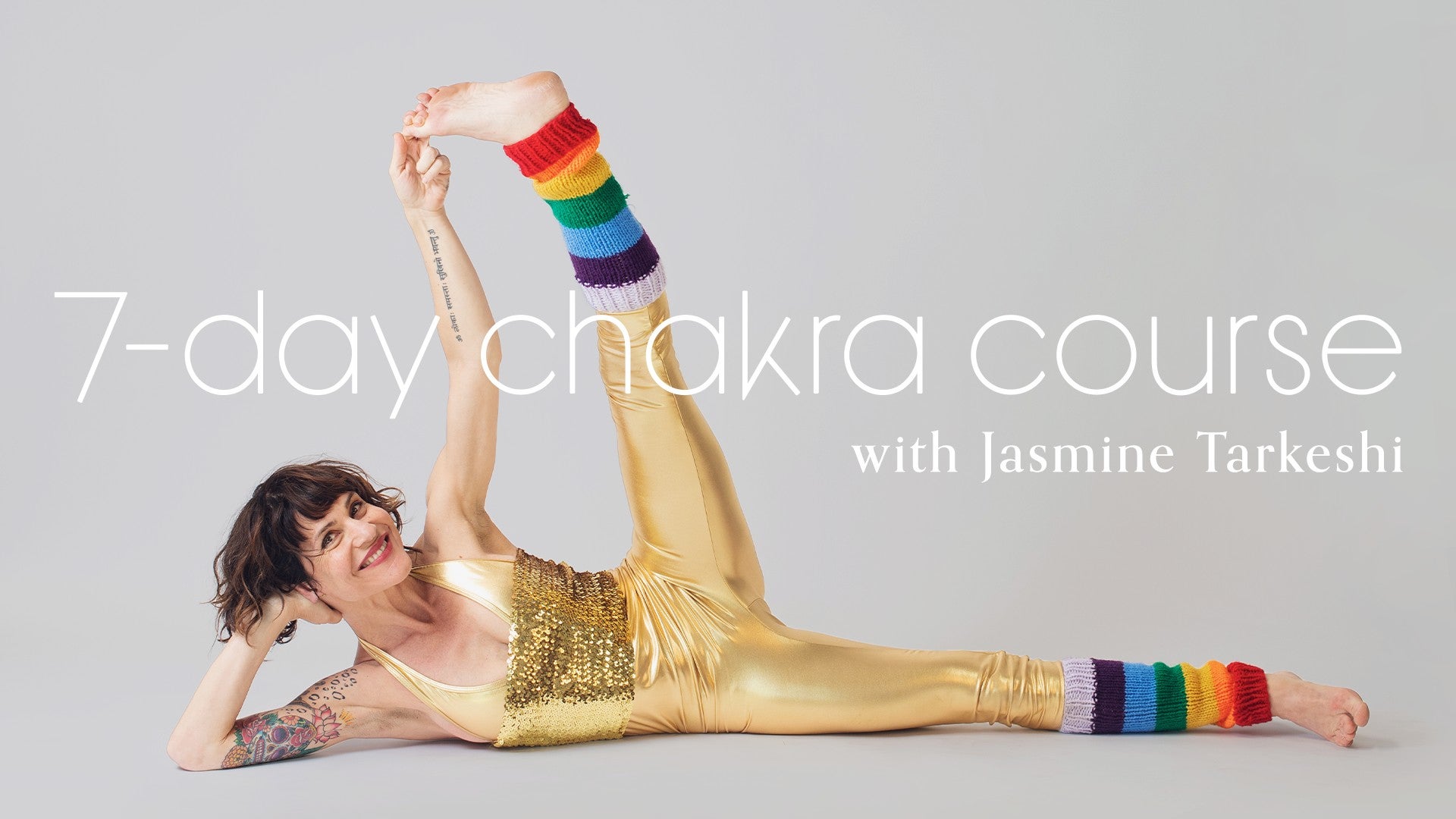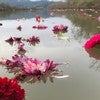Description
See the attached PDF chart for this chakra.
About This Video
Transcript
Read Full Transcript
Introduction
Wow, welcome back. We're here at week six in our seven week chakra course. So just like as we've been climbing up this inner ladder or for me, I like to visualize it like a mountain from those roots sinking deep into the earth and rising up for gifted new eyes to be able to see the world and to look at ourselves with. So as we begin to rise up, we move right into the sixth chakra, the point between our two physical eyes, what's known as the third eye or in Sanskrit, it's called Ajna, which means to perceive, it means to know, sometimes it means to command and it's symbolized by a circle with two indigo pedals on either side. So you can kind of visualize this if you'd like, and it really looks like an eye. And those two pedals for me symbolize so much both sides of our brain that begin to actually work together. So it's the intellect and our intuition working in tandem. And it's meant to be really this eye of the feminine and masculine coming together. So of non duality that we can begin to perceive the world with instead of being entrenched in the guts of it, maybe before we've worked on all the other chakras, this allows us to look at the world, look at ourselves from this bigger perspective and the lens begins to open up a little bit. So as we begin to work on our developing this third eye, it's again, those hunches that we don't have concrete proof for, we don't have those physical proofs for, so the rationalist in us may get a little bit annoyed. But as we do, we're pushing away the great wisdom that's gifted to us. Sometimes it's called the inner guru that we can begin to bow to after we've gone through teacher after teacher, we've searched for answers everywhere. We begin to trust the sixth sense that exists of our great intuition. Sometimes we may go to a psychic, we may go to an astrologer to answer some of life's biggest challenges and biggest questions. But by working on our Ajna chakra, we begin to have faith and develop confidence and that we can begin to answer some of these answers to life's biggest challenges and questions. So today's practice is going to be a little shorter. So it's going to be a bit of a moving meditation. The bulk of the practice is going to be through visualization, through meditation so that we can use our mind's eye to visualize our life, to begin to answer some questions. We're going to do some breathing practices, but for your homework through the rest of the week, your great assignment is going to be to take a few moments in meditation and then be able to intuit or to tap in to see if you can be guided from within which one of those five sequences that we've been exploring this whole week leading up to the sense you most need. So this is one of the greatest ways in which we can begin to strengthen and awaken our Ajna chakra and our third eye. So let's go ahead and get started. We'rePractice
going to start with the mudra. So many mudras honor this great wisdom and the mind and the practice, but the one that I particularly love is called Hakini mudra. For me, it really symbolizes these two halves of the brain coming together in tandem to make a whole. So it's not this battle between the right and the left side of the brain, but they really have to come together, our intellect working with our intuition, to be able to again, take these chances in our life that were guided with great wisdom. So it's not just haphazard as it comes together and it really begins to stimulate the brain. So it also for me represents and looks like a crystal ball a little bit. So we're going to set up some space right here to sit up nice and tall. The sound that resonates within the third eye is the sound of alms, the sound of oneness of everything from where the universe comes from, beginnings, riddles and ends, it's non-dualistic vision that we can begin to have of the world around us. But it's very hard to actually hear and intuit if we haven't tuned in through our actual audible sound through the fifth chakras. So you're going to take a couple of breaths here and just allowing the focus, concentration to begin to drop down here towards your fingers. So we can first channel and train the mind through meditation to be nice and quiet, concentration so we can hear the inner voice. I'm going to take a few moments here. And then you can begin to take this mojo right up and towards your third eye, visualizing the great power of your brain to create really anything you desire to be able to visualize, no matter how far out it seems. Dissolve doubt. Let's take a breath in together for the sound of alms. We're going to do it three times. For the next one, open your arms, symbolizing those great wings of your mind. Enjoying your hands to your heart in prayer, honoring this inner guide, inner guru, inner wisdom, intuition. Make another big inhale. And exhale. You release your hands down. If you're padding out to the side, if you had it, we've been lifting our hips up. But for today, we're going to draw our head down. So right into a child's pose, one of the ways to stimulate and to bow our third eye towards the earth, the eye of awakening, of consciousness, to be able to look deep into life's messages. If we begin to awaken and stimulate this eye, we begin to see the meaning behind everything in our life. So take a couple of breaths. You can massage the third eye into the earth a little bit more. From here, rise up onto your hands and knees for a few rounds of cat cow again so that you're going to look up. Sometimes when we're answering questions, automatically our gaze looks up. Take a big breath in, take your gaze up towards the third eye, and then exhale, draw the gaze inward. And again, like that, inhale so that you're exercising even the eyes looking up. And then exhale, follow it in. So this is called your drishti, your gaze. Inhale and look up. And then exhale and follow it in. One more breath in to look up and then tuck your toes under, root down through the hands and the feet and then lengthen your legs into downward facing dog. Move a little bit from side to side. The ways to gain insight is to even close your physical eyes so that you can feel, you can see what's within. It's going to be kind of scary in yoga because you're upside down. But downward dog is pretty safe. If you externally rotate your shoulders away from the ears, press down through the hands and feet and then close your eyes. Insight, intuition, looking within, the answers. You can keep your eyes closed as you travel forward into a plank pose. Guide it into the shape as you lift up, extend back through the heels, forward through the chest, and then back into your child's pose as you breathe out. And then like Alice in Wonderland, go in just diving down into that mystery. See if you can travel forward, keep your eyes closed. It's fine if you need to open them up into a baby cobra from there. You can open your eyes and breathe in, look up. And then come back onto your hands and your knees. Tuck your toes under for downward dog. And let's do that twice more. Come forward into a plank pose. See if you can keep your eyes open. It's moving meditation. Child's pose as you breathe out. Trusting. Baby cobra as you slither forward. Hands and knees and downward dog as you breathe out. And then just low on more time. Getting more used to it. Plank pose. Child's pose as you breathe out. Slithering forward into your baby cobra. This time back into a child's pose as you breathe out. From here you can absolutely open your eyes. You're going to press down into your shins and then circle your arms up and above you. You'll see with new eyes, I promise. You can take a hold of your Hakini mudra above you, even take it behind the head. So it is this guidance. And then you can swing your arms as you bow your head down to the ground. Play with maybe the fingertips coming together behind you.And then again, press down through the shins, rise up. And then drop your head. Maybe the hands back behind you. One more time, just like that. Exhale and drop your head. And then rise up. One more time. And this time you're going to step the right foot out and in front of you for Anjanaasana. So just allowing the hips to sink down and the hands can come behind the head as you look up with great wonder. So this is the tapping into imagination. All the different possibilities as you begin to take the gaze in and up. And then from here as you come on down, you're going to parallel your left shin with the back of your mat. So it's this center of the mat. And see if you can have a seat on your left heel and then slide the right foot a little bit closer in towards your heel. And then your hands are going to come to your heart. Let's see if you can take a little bit of a twist and then take the right hand to the ground and your left arm to the sky so that you're sinking into the earth, reaching your arm up nice and high. For a seated Tara, she's the great goddess of wisdom. Take a big breath in. You're welcome to twist open a little bit more with the left arm snaking behind you towards your inner right pocket. And then plant your left hand to the floor behind you. Press into the left shin, stretch the right leg out. You're in a nice stargazer looking up and back. From here you're going to swivel to the back of the mat. So you're going to come onto the ball of the right foot. Draw the left knee in towards the third eye. Give it a little tap if you can. Take it into a plank pose as you breathe in. And then child's pose as you breathe out. You'll slither back out into your baby cobra exploring. Eyes closed so that the third eye can open of consciousness. And then back into your child's pose. Do a few more with those breathing as you press into the shins. Take your hands behind you. Drop your head, swing the arms back. And press down and rise up. Then taking your insight back into your beautiful eyes. Take one more big breath in. And then clearing everything out. It can even become like a kapalavati, skull shining. One more big breath in. Let the hands drop behind the head. And this time you'll step the left foot forward. Look up and back. Right in towards the third eye. And then as your hands come down, again towards the inside of the foot, swivel the right shin. Have a seat onto your heel. Come up to sit nice and tall. Climb your left shoulder to your left knee. Take the left fingertips down, the right arm up. Twisting a little bit deeper.
Roll the right shoulder a little bit further away from the ear. And then plant the right hand to the top of the mat. Stretch your left leg. Right arm shooting out. Come onto the ball of the left foot and draw the right knee as high up as you can to tap the third eye. Plank pose as you breathe in. And then child's pose as you breathe out. Another breath in. And then a big breath out. Slowly begin to rise up to sit, having a seat on your heels. And then slide your hips over to one side. Extend your legs out and in front of you. We're going to make our way into Janu Shri Sasana, which literally means head to knee.
And again, stimulating and taking our gaze and our vision and awareness for deeper insight within. So you can bend the right knee and slide the sole of the right foot to the inside of the left thigh. Take your left fingertips behind you and your right arm to the sky. I always like to put a slight bend. I tend to hyperextend in the back of my left knee. Just a slight bend. It allows the way to shift forward to the fronts of the sitting bones. The spine can get a little bit extra long, taking out the roundness. And then begin to come forward a little bit at a diagonal. So the whole right side of the body is going to be invited over to the left as you reach for the outer edge of your left foot with your right hand. You can even draw back a little bit and then kind of swan the left hand to the inside of the left foot. You can bend your elbows a little bit and look up. And then again, as much as you need to bend the knee so that the third eye can make contact with your head for today, the better. We'll take a few deep, slow breaths and finding those slight pauses at the height of the inhale and the depths of the exhale. We can maybe hear this inner guide.
And take one more big breath in. Big breath out. And then as you inhale, reach the right arm forward. Let it circle all the way back behind you in another stargazer. As you press down, allowing your mind to open. Again, this imagination. Release your hips down and switch out your legs. Extend the right leg. Bend the left knee. Slide your foot to the inside of the thigh. Extend the left arm up. Rotate the left side of the ribs over to the right and then come forward. You can extend back, even look back, twist a little bit and then take your right hand to the inside of the right foot. As you stretch the chest forward and breathe in. And then exhale and fold forward. Looking within for the answers. And breathe all the way in. Breathe all the way out. And then begin to extend the left arm forward. Let it circle you up the floor behind you. Press down into your shin. Open up. And then release your hips down. So from here, we're going to set up the space for meditation and some pranayama. So always a little padding underneath your sitting bones is nice so that you can begin to lengthen the spine and allow the hips to drop down for as much comfort as we begin to develop a daily meditation practice for this week. So now we're going to take a few moments for a really powerful breathing practice that balances the two hemispheres of our brain. We have the streams within our body that are the carriers of consciousness and prana. And the two that represents a female and the masculine currents that move through our body actually intersect each one of the chakras. So from the very base of the spine, they're separate.
And they're the solar and the lunar channels called Ida and Pingala nadis. And so what they do is they intersect each one of the chakras kind of moving through like a caduceus, like that symbol of the snakes intertwining, piercing each one of the chakras until they begin to meet and intersect right here at the third eye. Like we've been talking about the feminine, the masculine side of the brain, the lunar and the solar channels that come together for this full vision of non-duality. So it's the yogic vision or hot sun and all the dualities that exist, dark light, we begin to see it as one as this eye begins to open. So to clear out these channels, nadi shodhana is so powerful. Nadi is of course the streams we've been talking about the currents and shodhana means cleansing or clearing the blockages through the chakras and everything else. It's very exciting. So the way that I like to do it is to actually take peace fingers, old school peace fingers, and you're going to place it to your third eye. Now the third eye you can kind of lift up. I'm just kind of first before I do it, I'm going to give a little bit of a visual to really explain it because it can be pretty confusing. There's different ways that you can do it, but this is to stimulate the third eye a little bit by lifting up. But just make sure that your head doesn't lift up because you do want the chin to continue to move in so that the piranha stays intact and the spine is nice and long. Your physical eyes close so that the third one can stay open. And then I'm going to use my thumb and my ring finger to alternate nostrils. So it's not just right, left, right, left. You exhale through one, inhale through one, and then you switch to exhale and inhale through the other. So I'll go through it a couple times. You can listen and then join in. But again, I'm using my right hand and you're not completely moving your nose over to the side or blocking it too tight. I see this a lot in classes too, where it's like the nose and the head moves. Everything wants to stay still. You're gently closing the nostril and then switching it. Okay, so let's get started. You're going to sit up tall with the shoulders draw back, rooting down through the first and second. The navel lifts up through the third and draws in and back. Your heart remains open. The chin moves in towards the chest and then this third eye begins to open. You can join your thumb and index finger symbolizing union with the self in the midst of the forces of nature or gunas. That's represented with these three ones. So everything becomes symbolic from this point on in our lives and practice. And then go ahead, take your peace fingers, prana mudra. You'll slide it towards the point between your two eyes, lift up a little bit, but then drop the chin. Close your physical eyes. Get ready by placing your right thumb on your right nostril and your right ring finger on your left nostril. So just placing them there lightly like you're playing a flute. And then inhale through both nostrils. Maybe it's about a count of three or four. Pause for a beat and then exhale all the way down and pause again. Inhale. Pause and exhale all the way down to your roots and pause. And then here we go. You're going to breathe in comfortably and then block off the right nostril and exhale through the left. Inhale left, switch and exhale right as you release your thumb. Inhale right, right thumb to right nostril, release the ring finger and exhale left. Inhale left, ring finger to your left nostril, release the thumb and exhale right.
Inhale right, switch, exhale left. Inhale left, switch, exhale right. Inhale right, switch, exhale left. Inhale left, switch, exhale right. Inhale right, switch, exhale left. Inhale left, switch, exhale right. See if you can do this around three more rounds on your own. It's a full round all the way through the right. One more round. And then release both hands down. Breathe in through both nostrils and inhale. And exhale. Your hands can remain open to take another breath in. Being open to receiving the messages. Breathe out. Slowly begin to open your physical eyes. And then we're going to end with a great visualization. You're going to use this mudra again of hakini. And for a very active practice, this is what you're going to take into your homework too. But it's to ask a question. Sometimes we can just have basic meditation or we can begin to visualize, we can stimulate this area to begin to develop faith in a direct relationship to this wisdom that exists within us, always guide us. So what you're going to do is with your hands back there and your focus, your visualization back in towards your hands, you're going to ask a question. And then with the physical eyes closing, you're going to take your tongue to the roof of your mouth. This is called the soft palate and it's directly connected towards the third eye. So some of these practices for the third eye, we have to have faith. They're more mystical. They're not as physical. They're a little bit far out, but it is this imagination and faith that we can begin to have. So you breathe in, take your tongue to the roof of the mouth, stimulate. The element is light. So it's like those aha moments, like a little light bulb goes out and then release it. And again, inhale, you're going to visualize, placing your tongue. Now, one thing you can do, which I was guided to in this meditation is to visualize a beam of light coming out. It's kind of like, imagine you're a minor and you have on those hats, you're going in the darkness, but you just have this light to be able to see where you're going. So that there's this beam of light. It's the eye of consciousness, of being awake, being conscious, being present. And let's just see what happens. So again, take a couple of moments. Your hands in this Hakini, you're stimulating the brain again by pressing the fingertips together. With your eyes closed, take the gaze in and up and back towards that indigo, two pedaled lotus. Within it, a downward golden triangle, symbolizing, bringing light and light and meant down to earth. This greater vision. So the physical eyes are closed, but the gaze and it's in and up and back. See, there is a question in your life right now about a direction you may want to turn to, or even why is this person in my life right now? Why is this happening right now? There's great answers. And then let's begin. So you're going to inhale, take your tongue, press it up and back to the soft palate. And then exhale and release, breathing out through the third eye light. Again, inhaling, taking your question right up there and then exhale and release.
Again, inhale, tongue moves up. Exhale, you release and do that six more breaths. Inhaling, exhaling. Inhale, exhale. We've got three more. Again, imagining breathing out right through that point between your third eye. And breathe twice more. Last one. Allow your hands to fall down to your knees. It's up in your face. Your palms open again in this receptive gesture. Receive the answers. You sit here together like this for just a few minutes. Place your mind on your breath. If it travels, just bring it back. Exhale. Exhale. Exhale. Take one more big breath in. Exhale completely. And then join your two hands back at your third eye and joining the two halves together. I'm going to take one big breath in here for the sound of Aum. Aum.
Release your hands down. If any answers were revealed through that meditation, make sure to write them down. But let's bow down and honor this great light, this great awareness that exists within one another. Namaste.
Talk
Let's look now deeply into our sixth chakra, the third eye, Ajna. We're exploring a little bit. Ajna means to perceive, to know, and so its function is to be able to intuit. And also to be able to see, even though the third eye is between our two physical eyes. Again, we can't see it, so it is this trusting in what we can't actually see or hear or taste, anything that's really physical, but things that we know, these hunches that we have. And again, the element is light. So it's like a light bulb going off. Those aha moments when we get things. So it's related to sight. It's also related to our mind and being able to know, being able to see clearly. So right away I'm going to get into the shadow, which is illusion. And so much of the time we look at the world through, you know, this kind of fun house perspective of the world. We're looking through the world through all of our past experiences and things get distorted. One of yoga's main teachings in philosophy and the yoga sutras is how can we begin to dissolve what's called the samskaras or the ways in which everything becomes distorted in which we see. As we can imagine, everybody looks at the world in different ways, depending on their own personal experiences. So by the time we've purified and worked through all of our chakras, it's meant to be that some of this delusion begins to lift. And hopefully we can begin to see a little bit more at past a separation and really experience this true oneness that it's at the heart of the universe. So it is more of this mystical seeing and seeing beyond what just looks real. So a lot of the time it has to do with the messages that we're being given so that we can read what's going on in the world. Why somebody's in our life? Why somebody moves away? Why is certain things dropped in our life? We begin to experience the meaning and see deeply into the experiences of our life. Another function of our Ajna chakra is about dreaming and our psychic abilities. So to be able to dream seems like perhaps a privilege, not only in our, when we're sleeping dreaming, but to be able to visualize, to be able to look about how we would like to see our life, how we would like to see the world and imagine. So our imaginative mind, when we're younger, we're so imaginative. And as we get older, our world begins to, the lens begins to close and get very, very narrow on who we think we are on our life. And so to be able to expand it, see past these really strict identifications that we place on ourselves. It's a big aspect of the Ajna chakra. So some of the symbolism, some of the qualities we went into the symbolism of the two peddled indigo lotus with the two halves of the brain. I love the color indigo because first of all, it's my daughter's name. Secondly, it really is the time of day dawn and dusk. It's where it is non-dual.It's not day, it's not night. Those are meant to be the most mystical times of the day, where it's these in between states where we can't fully define, this is light, this is shadow, but it comes together in those mystical, mystical states of this great, great color indigo. The other is the sound om, it's the one mostly known, the mantra that we hear mostly associated with yoga, and it is beginnings, middles, and ends, everything in the universe coming from this sound. Everything was born out of sound and the great colors associated with the universe. So the more we can begin to chant om, the more we can begin to unite and to begin to hear and to begin to see a little bit deeper. Past our stuck perspective that just opens things up. Element is light and even slight thought. Physically on the body it's the physical eyes and then the base of the skull, the occipital ridge. Also, all of our nerves, it's like the neurological system, I think is associated with this Ajahnachakra. So the gland that's associated with the, and this one between the sixth and seventh, there's so many different perspectives and you hear the, you know, always in yoga that, you know, there's different views, but the pineal and the pituitary always kind of dance around whether it's sixth or seventh. I think at this point we can choose whichever one you want and sorry not to be definitive. But I associated more with the pituitary, even though the pineal glands having to do with light and day and regulation of night and day could also be associated, but the pituitary is the master gland of the whole system. So everything, all the functions of the body, of the chemicals in the body, of the hormones in the body, the cycles without having, you know, it's like how does this happen? It's a great miracle, it's a great mystery, but everything's underneath the command center. The pituitary gland that's right behind the occipital gland, right towards the third eye, that again regulates all of the hormones, all of the chemicals within our bodies and our brains and really functions towards mental health and regulation of our nervous system. So how can our third eye go out of balance? Physically it's meant to be with a lot of headaches, even migraine headaches, vision problems, glaucoma, blurred vision, blindness of any sort, eye problems, neurological difficulties are all meant to be there, all associated under the physical ways in which it can manifest when our third eye, our sixth chakra, is out of balance. For me it was a big hormonal thing, you know, things like the inner clock wasn't functioning, but it was the pituitary, let's say like my monthly cycle. So it was all regulated from how the pituitary gland functions inside of the body. So that's a way we can kind of see maybe physically and then some of the mental, emotional ways that can go out of balance that we can begin to perhaps detect is that if it's under active, if it isn't functioning very well, well, we don't have a real grasp on reality. You see people who just are blind to what life messages are telling them really exist in a state of delusion. They have a hard time focusing, they have a hard time even being disciplined. It's meant to show up in that way. Other things are just like we were talking about with the mind memory problems, difficulty learning, grasping things, being able to differentiate between inner and outer, what's real and what's not real. Fantasies, nightmares, these kind of ways that our third chakra really isn't functioning to the greatest of our ability to be able to guide us. If it's overactive it can be the other way, which is more dogmatic, highly intellectual. When we over intellectualize everything we can't see anything beyond what has rational proof. And so that's why I always love Blake's poem, To See the World in a Grain of Sand, to see the big picture in what seems so tiny, heaven in a wildflower, infinity in an hour. This was a great yogic perspective about seeing this infinite reality even within each small thing that exists, God existing within every tiny particle on the planet. So when it's overactive it really is just dogmatic like, no that doesn't exist because I say so. And then even when it's maybe overactive it can lead to, when we see people that are so out of touch, who are just like we can say like, oh my God, they're on another planet because they don't see reality if it's way too open and aren't as grounded and can tend towards hallucinations, really moving like far out into the other realms, but no grounding. It can go in the opposite direction. So either being highly rational or then highly irrational. So again, we're remembering that it's the intellect and the intuition and that how they balance. So when they're out of balance it's either one way or the other that it can go. So what does it look like when it's in balance? We're highly intuitive. We begin to have a little bit more faith in what the world is telling us, what our life is telling us. We're more at ease than life. We can see what's beyond the surface, whether it's a person or again, what things appear to be. We see them as they are. And then again, the great meaning that life is giving us. So it's just being able to see and to see clearly and to intuit and to be able to imagine. We're able to see ourselves as one with the universe instead of so separate and basically live a happier, healthier life. So this week, as you begin to do your meditation practices and then again, set the space to be guided from inside what you need to begin to work on creating an altar to honor this inner guru or inner guide of your intuition is going to be really fun and really helpful. So one of the things that I love to explore are things like tarot cards. So that's also when it's in balance because it helps us to have faith and just to be guided and not have the mind really like grasp on things of the way that we tend to see things. So putting, you know, maybe picking a tarot card, this is what I do. I pick a tarot card every day and I put it straight on my altar to honor my third eye. And again, a guidance that comes from, we don't know where, but to just be able to listen and to do whatever it says to do, right? It can be kind of scary, but it's letting go of control and being able to be guided. Things like a crystal ball are really wonderful again just to be able to stretch our imagination, to be able to see a little bit more into crystal diamonds too. If you happen to have diamonds or crystals, diamonds expresses diamond consciousness of the mind that we talk about so much in Buddhism and in yoga philosophy that reflects reality like a crystal reflects all the colors from around it. It sees it's pure beyond that distorted mind that we're trying to move away from an illusion and delusion of reality. Other things you can do, just light to be able to see a candle or light bulb, anything that's indigo. So things like a mandala is really nice or just even a picture of that third eye. You can even draw one, a circle with two indigo wings. Just the color indigo is so mystical and can take us into this space for meditation. Dream catchers, it's a symbol of being able to catch your dreams and whether they're daydreams. When was the last time you let yourself daydream? Our minds are usually so busy focusing on things we have to do that we don't let our minds be free and dance and imagine and play. So a dream catcher to catch your actual dreams and then again maybe an indigo journal to actually write down your dreams. Keep it by your bed, sometimes it can be scary. But it's so interesting and to be able to develop a relationship with this unconscious world that we're not so in tune with. We're beginning to develop a relationship and a real connection to this inner self. So those are some things you can begin to place on your... I have a picture also of the thinker, right? Rodin, the great thinker, just looking. You always see children even doing this. Or you may look up, but the great power of the mind and thought to reawaken.
Homework
So you can create this space for yourself, for your practice, for your meditation and whatever practice you're guided to do that week. And then the few other things you can begin to add into your practice this week and the questions that I have for you are really based on, you know, how much time do you carve out during the day to truly be able to listen, right? Where you can quiet the mind, where you can allow the cacophony of the mind, kind of the beehive of the mind to quiet down so that you can listen truly to the guide that exists within you. So carve out the space and that time for yourself. And then another thing is this visualization. So especially if you are in somewhat of a darker space, it's to visualize. So it's not to pretend that things aren't there, but that we can switch our perception. So in Sanskrit, this is even called pratipaksha bhavana, to be able to switch our perspective, to focus on something beautiful, to visualize something beautiful. It could be a child's face, it could be beautiful flowers. Instantly for me when I look at beautiful flowers or a beautiful image of something, I'm uplifted a little bit. So it's this choice of where our mind goes as we begin to think about this mind's eye, what we want to see. And again, not to deny anything, but that we can begin to switch our perspective a little bit. So as we begin to invite more silence into our lives, we can begin to hear these whispers of intuition a little bit more. And then the second question is, how much time or what's your relationship like with your intuition? When was the last time you really acted on it? That something told you something, whether it was, sometimes you think gut feeling or light bulb moment. When did you actually act on your intuition when you were guided? Maybe it is even to walk down another street. Usually we'll kind of like, no, I'm not going to do that. I do this every day. Why would I do that? But see if you can begin to write down if your intuition is telling you something like, ah, this feels a little bit off. I'm not going to do it. We generally do it anyway, or I'm doing this thing every day. I know I should do something different, but we do it anyway. We usually don't listen. The voice isn't as loud as thoughts in our minds that tell us, you know, you should do this, you should do that. It's like a big rationalist. But if you can write them down and then maybe act on one, it could be something simple. It doesn't mean like, leave your job and move to Peru. Even though that sounds fun sometimes. But just a simple one. See if you can hear a little bit about how your intuition guides you. Write it down and then do one simple thing or take one little step in that direction. And then the other thing is beyond just even the intuition is how much do you really see the world around you? This I think in modern day too, I talk a lot about cell phones just because it's our reality right now. We're so tuned out that we don't see one another. So another great, great, great, the universal right that has to do with the six chakras, the right to be seen. So just like as you begin to sit and develop your practice of meditation, you're allowing yourself to be seen as you are, to be able to be heard, you know, all these different rights that we've been talking about. But also how much can you actually see the world around you? How are you seeing the flowers around you? How much do you see what's there right in front of you? Usually we're so stuck in our mind that we don't see the beauty that's around us, the reality that's around us. And sometimes I can't believe I didn't see that. I say this all the time. It was right in front of me. I didn't see it, right? Because we're usually somewhere else. It could be also something that needs to go, right? We can begin to see like this no longer serves me, right? But first we have to be able to see and to be present. So it could be in colors and shapes. Maybe write down doesn't necessarily have to be a poem, but sometimes I'll go sit somewhere in a bench and I'll literally write down the things that I see so that I'm more in contact with the world around me. This in itself becomes a meditation because our thoughts still to focus on what's around us, describing it in detail, right? So color and light and all of that is meant to be a part of our third chakra to truly see ourselves and others. And then this last one we practiced a little bit through the meditation, but it's how much do you look outside of yourself for the answers? And of course we go online, like anything that'll happen, I go Google it, right? Like this great mystery guru that can tell me everything and your physical thing or mental, emotional disturbance, something in a relationship. I go like, ah, what does this mean? And that's all awesome because we get so much information. But then at the same time, how much do you spend time or can you this week take some time to look inside of yourself for the answers?What kind of messages are being played out? And a lot of the time, you know, we can call it destiny ends up stepping in, right? These messages are being played out that we're just not tuning into that we don't want to see. For me, there was a time when a particular passion had died, but I didn't have the courage to take the steps to move beyond it. I was being guided towards a spiritual path and taking a different direction in my life, but I didn't want to disappoint anyone. I didn't want to take these steps until destiny stepped in and was just like, okay, and gave me a harsh blow. You know, I had an accident, so I couldn't keep doing what I was doing, but I remember being so grateful because what I couldn't do for myself was being played out by let's just say the mystery. So the more we're listening to the messages, maybe we don't have to have some of those tough blows in our lives. Maybe we can meet destiny or our lives halfway so that we can listen to the messages being played out and then tune in, listen, act on them a little bit more as our relationship to this inner guide can become stronger. So those are some big questions, some big practices to begin to invite into your life as well as it could be really any time that you set out to begin to see which practice do I need, what part of me needs attention, what part of me is neglected as far as chakras one through five and do those practices during that day to begin to honor your inner guru. So if you have any questions, if you have any comments this coming week, because it is a little bit more subtle, more mystical realm of our lives, please feel free to ask any questions and I'll see you next week for our final chakras. We begin to rise on up all the way to the top. So thank you for joining me this week and I'll see you soon. Namaste.
Chakra Course
Comments
You need to be a subscriber to post a comment.
Please Log In or Create an Account to start your free trial.
























